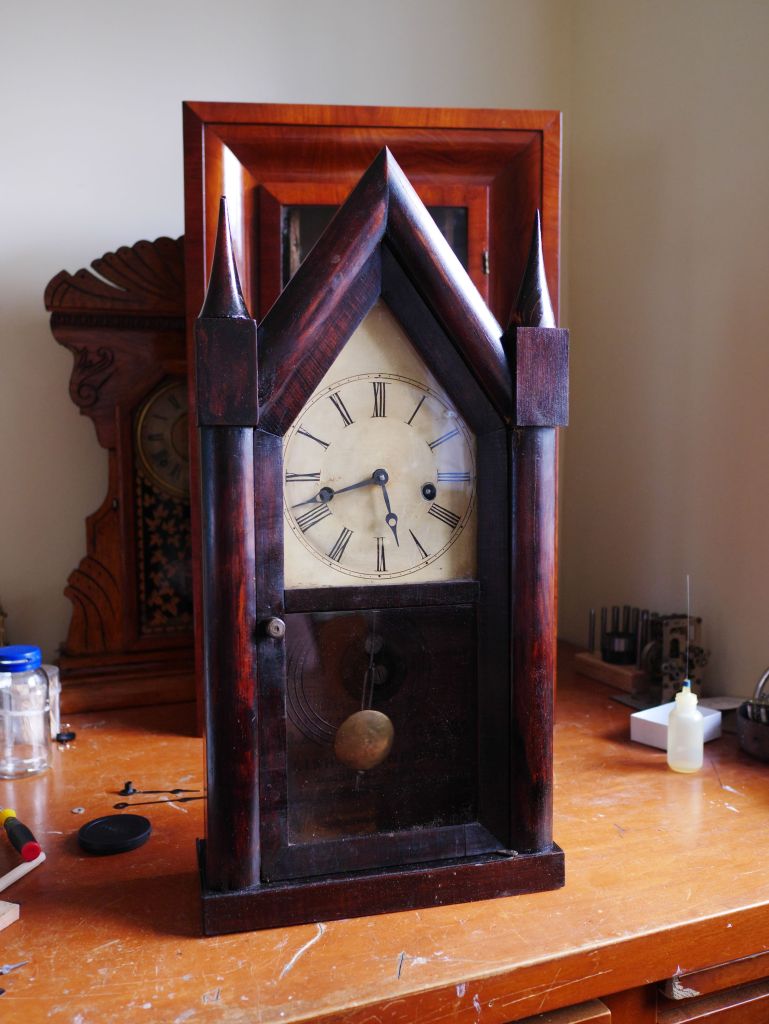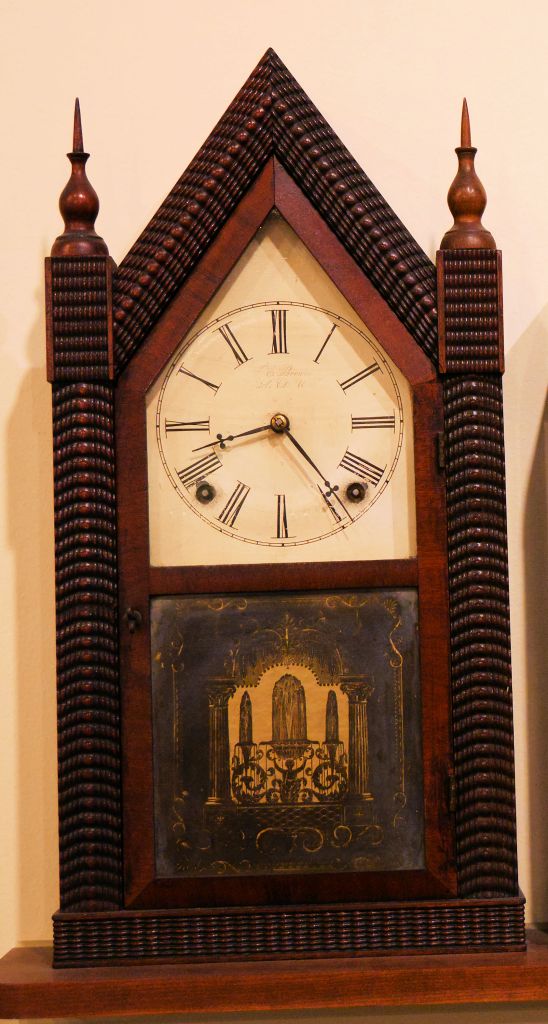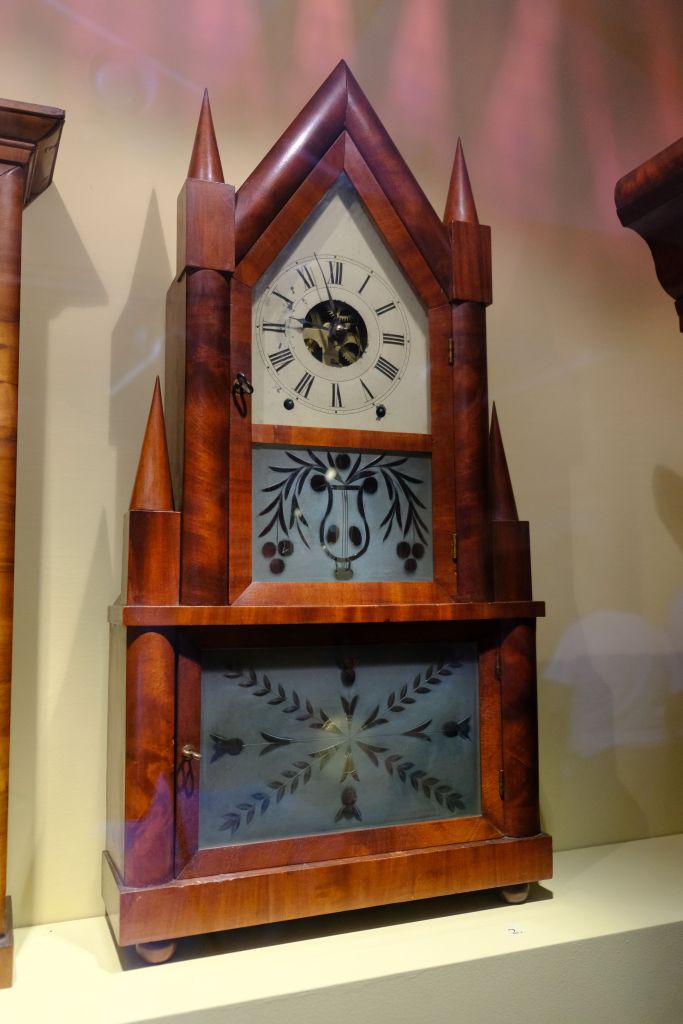A steeple clock is a type of clock designed to resemble a miniature church steeple or spire. This style of clock is often characterized by its tall and narrow structure.
These clocks gained popularity in the mid-19th century and were often produced in various styles. The design was influenced by the Gothic Revival architecture that was prevalent during that period.
Steeple clocks are relatively common in North America as thousands were produced in America particularly but rare in other parts of the world.

In my collection, I own three steeple clocks – the first, crafted by the American manufacturer Elisha Manross, the second by the Hamilton Clock Company of Hamilton, Ontario, and the third by The New Haven Clock Company of America, made for export and sold by Thomas Spike Jewelers in Halifax, Nova Scotia in the 1880s.
All three share a commonality with their time and strike 30-hour spring-driven movements.
The Elisha Manross steeple clock stands out with its distinctive use of tempered brass mainsprings, marking a period between 1836 and 1847 when this material was the motive force for spring-driven clocks. It represents a technological glimpse into an important era in American clockmaking.

However, it is the steeple clock from the Hamilton Clock Company that holds a special place in my collection. Being a Canadian collector, the clock not only adds historical charm to my collection but also carries significance because it is Canadian-made.
Crafted in Hamilton, Ontario, it embodies a piece of Canadian horological heritage, making it more than just a clock but a connection to the craftsmanship and legacy of clockmaking in Canada.

The Hamilton Gothic steeple clock stands out because of a religious inscription, “Cling to the Cross,” delicately etched onto the lower glass tablet. It is a rare clock from the Hamilton Clock Co., which manufactured a variety of clocks of every style over a very short period.
The historical weight of this 30-hour steeple clock is underscored in Jim Connell’s description in a video he produced several years ago. Connell, a figure renowned in Canadian clock circles, whose acknowledgment of the clock’s rarity adds an extra layer of importance to this find. Fun fact, Jim Connell invented salt and vinegar potato chips.
This clock carries whispers of a bygone era, a testament to the Hamilton Clock Co. which, between 1876 and 1880, made a valiant though short-lived attempt to compete with the growing number of common clocks coming from the USA.
Steeple clock discussion
The term “Gothic steeple clock” specifically refers to clocks that incorporate Gothic design elements, such as pointed arches, into their structure.

Steeple clocks can vary in features, including different types of movements.

The vast majority were relatively simple designs that were spring-driven but there are some very rare examples of steeple clocks that are weight-driven and ones that incorporate fusee movements.

R. Blakeslee, Jr. in or around 1850 made a 30-hour weight-driven clock with a lyre movement (not pictured). His clock also featured a compound pulley configuration on the time side, the time side weight being heavier than the strike side.

Even more unusual are double-steeple clocks, a noteworthy example being a Birge and Fuller 8-day fusee-powered brass movement clock (not pictured) made in the mid-1840s.
During the same period, Elisha Manross made a double steeple shelf clock that had an 8-day time and strike strap brass fusee movement with a 12″ pendulum (not pictured). It features the original stenciled and painted tablets by William B. Fenn of Plymouth. William Fenn was one of the more prolific tablet makers of the mid-19th century.
By comparison to a conventional steeple clock that stands at about 20 inches, double steeples are over 6 inches taller.

Jerome & Co. of Chauncey Jerome fame also produced a double steeple in 1850. The one pictured above features a portrait of the seventh President of the USA, Andrew Jackson.

Steeple clocks are appreciated by collectors for their historical charm and unique aesthetic, reflecting the craftsmanship and design of the era in which they were produced. They also stand as tangible expressions of the artistry and cultural influences of their respective historical periods.

Steep
LikeLike